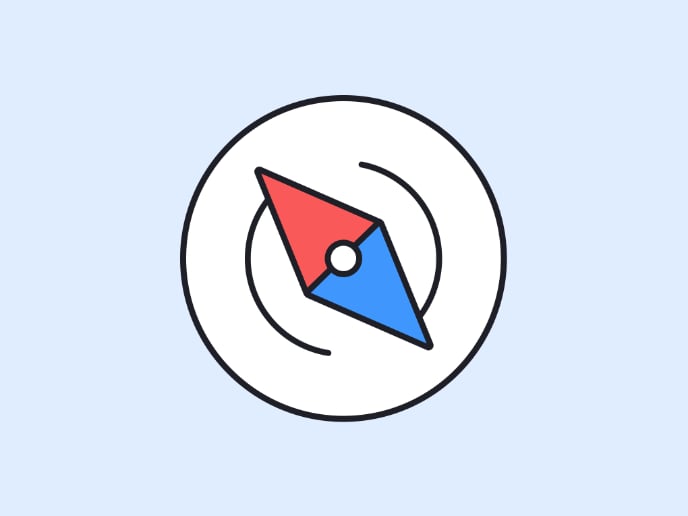A Practical Guide to Coaching Designers - Part 1
Unlock design leadership potential. Master servant leadership and powerful coaching models GROW and OSCAR to nurture design talent.
In the world of design, there are managers, and then there are visionaries. The difference? It's not just about talent or experience. It's about the ability to inspire, to lead, and to nurture the next generation of design innovators. This is the story of how you can become that visionary.
Leading to Serve
Imagine two types of leaders. The first walks into a room, and everyone straightens up, eyes forward, a bit on edge. The second walks in, and the room relaxes, ideas start flowing, and there's an energy in the air -- the kind that sparks innovation.
Which leader do you want to be?
Here's the kicker: the second leader? That's a servant leader. And that could be you.
Now, I know what you're thinking. "Servant leader? Sounds a bit... well, subservient." But here's the thing – it's actually the most powerful form of leadership there is. It's not about being a doormat; it's about lifting your team up so high that they can see possibilities they never imagined before.
Think about it this way: What if, instead of climbing the corporate ladder, you became the ladder? What if your success was measured not by how high you could climb, but by how many people you could lift up with you?
That's the essence of servant leadership. A servant leader:
- Views power as a tool for upliftment, not control
- Measures their success by the success of their team
- Celebrates when team members surpass their own skills
- Creates a community where growth is the ultimate goal
- Begins each day with a simple question: "How can I help my team shine today?"
But how do you become this kind of leader? It's a journey, one that requires cultivating certain traits:
- The Art of Listening: Active listening gives you the ability to truly understand your team's needs, desires, and concerns. It's not just about hearing words—it's about understanding the meaning behind them, the emotions driving them, and the unspoken messages in between.
- The Power of Empathy: Empathy is your secret weapon in leadership. It's the ability to step into someone else's shoes, to see the world through their eyes. When you lead with empathy, you're addressing root causes, not just surface-level problems.
- The Gift of Awareness: Think of awareness as your leadership radar. It's about being tuned in to the subtle undercurrents in your team and environment. When you're aware, you can spot potential issues before they become problems and identify opportunities that others might miss.
- The Skill of Persuasion: Forget about giving orders—persuasion is your new superpower. It's about inspiring your team to see and embrace the best path forward, not because you said so, but because they believe in it.
- The Vision of a Dreamer: As Jobs said, "The people who are crazy enough to think they can change the world are the ones who do." As a leader, you're not just managing the present—you're shaping the future. Big picture thinking is about seeing beyond immediate tasks to larger goals and possibilities.
- The Commitment to Growth: Your success as a leader is measured by the success of your team. When you commit to building up your people, you're creating a powerhouse team that can tackle any challenge.
The Power of Coaching: Nurturing Design Talent
Now, let's talk about coaching. This isn't just about correcting mistakes or giving directions. It's about nurturing talent, fostering innovation, and helping your team members unlock their full potential.
Here's how you can transform every interaction into a powerful coaching opportunity:
Build Collaborative Relationships
The most effective coaching relationships are built on collaboration and mutual respect. When you approach coaching as a partnership, you create an environment where trust flourishes and learning becomes a two-way street.
Embrace Humility
Admitting you don't have all the answers doesn't make you weak—it makes you relatable and infinitely more effective as a coach. When you show humility, you open the door to fresh perspectives and innovative ideas.
Guide Through Thoughtful Questions
Your role isn't to be the font of all wisdom. Your true power lies in asking the right questions—questions that challenge assumptions, spark creativity, and guide your team to their own brilliant solutions. For instance:
- What user problem are we truly solving here?
- How might we challenge our initial assumptions about this design?
- If we had to explain this design to a five-year-old, what would we say?
- What would this design look like if we had unlimited resources?
- How does this design reflect or challenge our brand's values?
Implementing the 5 Whys Strategy
The 5 Whys is a powerful technique for getting to the root of design decisions or challenges. Here's how you might use it:
Initial Question: Why did we choose this color scheme?
- Why #1: Because it's visually appealing.
- Why is visual appeal our primary concern here?
- Why #2: Because we want to grab the user's attention.
- Why do we need to grab attention in this particular way?
- Why #3: Because we're trying to convey energy and excitement.
- Why are energy and excitement crucial for this product?
- Why #4: Because our target audience values these qualities in their daily lives.
- Why do these qualities resonate with our specific audience?
- Why #5: Because our research shows they're seeking products that enhance their dynamic lifestyles.
By the fifth Why, you've often reached a fundamental insight that can guide design decisions more effectively than surface-level preferences.
Help Your Team See the Big Picture
In the fast-paced world of design, it's easy to get lost in the details. Your role is to be the compass, helping your team navigate without losing sight of the big picture. Help them prioritize their efforts, focusing their creative energy where it will have the most impact.
Unlock Intrinsic Motivation
True motivation for creative professionals comes from within. Your job is to uncover what truly drives each member of your team. Is it the thrill of solving complex problems? The satisfaction of creating beautiful designs? The impact of improving users' lives?
Master the Art of Feedback
Giving feedback is a delicate dance that requires grace, empathy, and precision. Lead with encouragement, highlighting the strengths and potential in every piece of work. Then, frame your constructive feedback as opportunities for growth, not criticisms of failure.
Most Impactful Coaching Models for Designers
Think of these coaching models as the ultimate UX for professional development. Just as we meticulously craft user journeys to guide people through digital experiences, these models provide a framework to navigate the complex landscape of personal and professional growth. They're like well-designed interfaces for the mind, helping us access deeper levels of creativity, problem-solving, and self-awareness.
In part 1, we are about to explore two coaching models that stand out in their ability to elevate design thinking and unlock potential: GROW and OSCAR. Each of these models is like a different design thinking methodology, offering unique approaches to frame challenges, ideate solutions, and iterate on personal and professional development.
GROW Model
In the world of design, creativity often seems to flourish in chaos. But as a design manager, you know that true innovation comes from a blend of creativity and structure. This is where coaching models come into play, and none is more powerful or versatile than the GROW model.
GROW, first popularized by Sir John Whitmore, stands for:
- Goal
- Reality
- Options
- Will
Think of it as a roadmap for your coaching sessions, guiding you and your designer through a journey of discovery and action. Let's explore how you can use this model to unlock your team's potential.
Step 1: Goal
Just as every great design starts with a clear brief, every great coaching session starts with a clear goal. This is where you help your designer envision their destination.
Remember Steve Jobs' words: "Start with the customer experience and work backwards to the technology." In coaching, we start with the desired outcome and work backwards to the current reality.
Use these questions to help your designer set a clear, inspiring goal:
- If this project were to exceed all expectations, what would that look like?
- How will achieving this goal change you as a designer?
- What impact do you want your design to have on the user's life?
- If you could fast-forward to the end of this project, what would you want to see?
- How does this goal align with your long-term vision as a designer?
Step 2: Reality
Now that you know the destination, it's time to understand where your designer is starting from. This is where the 5 Whys strategy can be particularly powerful.
Start with a broad question about their current situation, then dive deeper with each "why". For example:
- Why do you feel stuck on this project?
- Why do you think that's happening?
- Why is that aspect particularly challenging?
- Why haven't previous approaches worked?
- Why do you think this challenge persists in your design process?
This deep dive helps uncover root causes and hidden obstacles, providing rich soil for growth and innovation.
Step 3: Options
In design, the ideation phase is where creativity truly shines. The same is true in coaching. This is your chance to help your designer brainstorm potential paths forward.
Here are five powerful questions to spark creative problem-solving:
- If you had unlimited resources, how would you approach this challenge?
- What would your design hero do in this situation?
- How might we solve this problem if we were designing for a completely different industry?
- What if we inverted our assumptions about this design problem?
- If this design were a living entity, what would it need to thrive?
Step 4: Will
The final step is turning insights into action. This is where you help your designer commit to concrete steps forward.
Use these questions to solidify their commitment:
- What's the smallest step you can take today to move towards your goal?
- How can you redesign your work process to support this action?
- What potential obstacles do you foresee, and how will you overcome them?
- On a scale of 1-10, how committed are you to this action plan?
- How will you celebrate when you achieve this goal?
Remember, the GROW model isn't a rigid framework, but a flexible tool. Use it as a guide, adapting it to each unique designer and situation you encounter.
By mastering this model, you're not just coaching—you're sculpting the future of design, one conversation at a time. You're helping your designers grow not just as professionals, but as creative visionaries capable of shaping the world through their work.
OSCAR Model
In the world of design, we're often told to "fall in love with the problem, not the solution." But what if there was a coaching model that flipped this on its head? Enter the OSCAR model, a framework that focuses on solutions rather than dwelling on problems.
Think of OSCAR as your design thinking toolkit for coaching:
- Outcome
- Scaling
- Choices
- Affirm/Action
- Review
Let's explore how this model can transform your coaching sessions into solution-focused design sprints.
Step 1: Outcome
Just as a mood board sets the tone for a design project, the Outcome stage sets the direction for your coaching session. This is where you help your designer paint a vivid picture of their desired future.
Try these questions to help your designer craft their vision:
- If we were to create a mood board for your ideal outcome, what would it look like?
- How would achieving this goal transform your design process?
- What impact would this outcome have on your users' lives?
- If your future self could send you a postcard from when you've achieved this goal, what would it say?
- How does this outcome align with your design philosophy?
Step 2: Scaling
In UX design, we use progress bars to show users how far they've come. The Scaling step in OSCAR serves a similar purpose. It helps your designer visualize their progress on a scale of 1 to 10.
Guide your designer with these questions:
- On a scale of 1 to 10, where 10 is your ideal outcome, where are you now?
- What design elements have you already put in place to get this far?
- What would moving up just one point on this scale look like in your work?
- If we were to create a user journey map of your progress, what milestones would we see?
- How can we gamify your progress towards this goal?
Step 3: Choices
This is the brainstorming phase of your coaching session. Just as designers generate multiple concepts before settling on a final design, help your designer explore various paths to their goal.
Spark creativity with these questions:
- If your design toolkit could magically expand, what new skills would appear?
- How might a designer from a completely different field approach this challenge?
- What if we applied biomimicry to your skill development? What natural processes could inspire your growth?
- If your future self sent you a blueprint for success, what would it contain?
- How can we repurpose your existing skills in innovative ways to reach your goal?
Step 4: Affirm & Action
In design, we create prototypes to test our ideas. Similarly, this step is about affirming what's working and prototyping actions for success.
Guide your designer with these questions:
- What elements of your current approach are already showing promise?
- If we were to create a minimal viable product (MVP) version of your next step, what would it look like?
- How can we A/B test different approaches to reaching your goal?
- What's the smallest design tweak you can make today that will move you forward?
- If your action plan were a user interface, how would you ensure it's intuitive and engaging?
Step 5: Review
Just as designers continuously iterate based on user feedback, the Review stage is about refining the approach based on results.
Use these questions to guide the review process:
- If we were to create a case study of your progress, what key insights would we highlight?
- How has your design thinking evolved through this process?
- What unexpected discoveries have you made along the way?
- If we were to present your journey at a design conference, what would be the key takeaways?
- How can we incorporate these learnings into your design process moving forward?
By framing the OSCAR model in design terms, you're not just coaching—you're co-creating a blueprint for success with your designer. This approach turns each session into a collaborative design sprint, focused on crafting innovative solutions and fostering continuous growth.
Conclusion
In this first part of our series, we've explored the foundations of servant leadership in design and introduced powerful coaching models to nurture talent. We've delved into the GROW and OSCAR models, providing you with practical tools to elevate your coaching sessions. In the next part, we'll dive deeper into more coaching models and practical strategies for implementing effective coaching in your design team.
Topics
Share
You might also like

Breaking into Product Management Through Paths Less Traveled

A Practical Guide to Coaching Designers - Part 2

How To Celebrate Failures With Your UX Team
Popular Courses

Leadership Mastery

Workshop Facilitation







